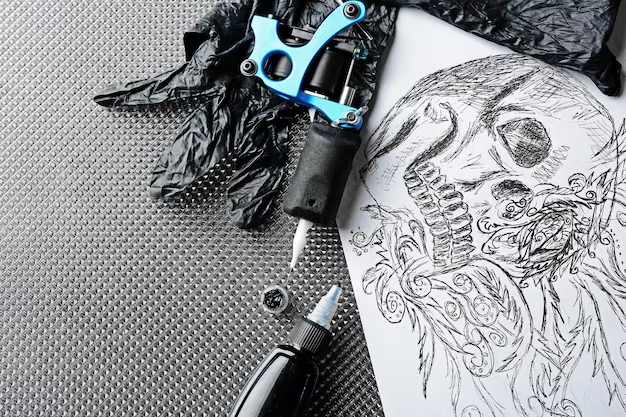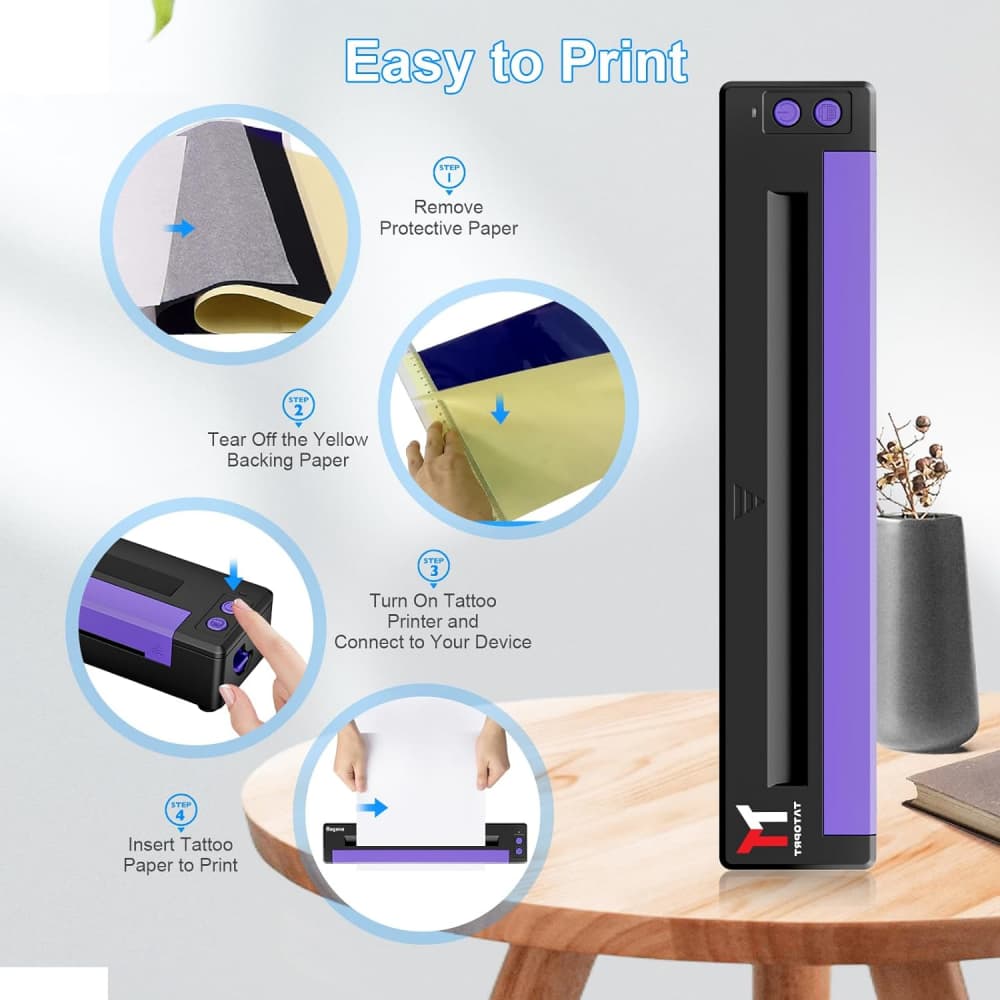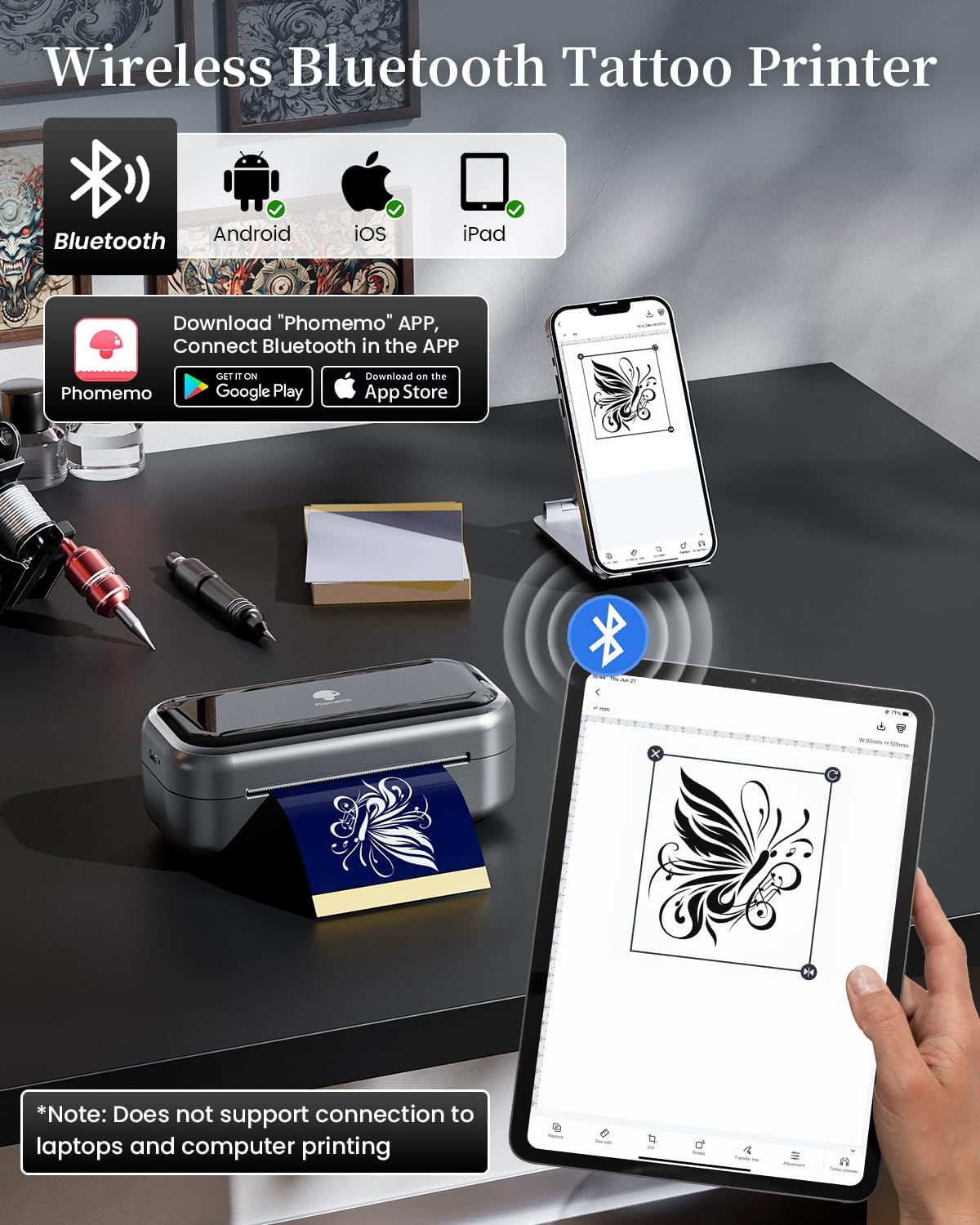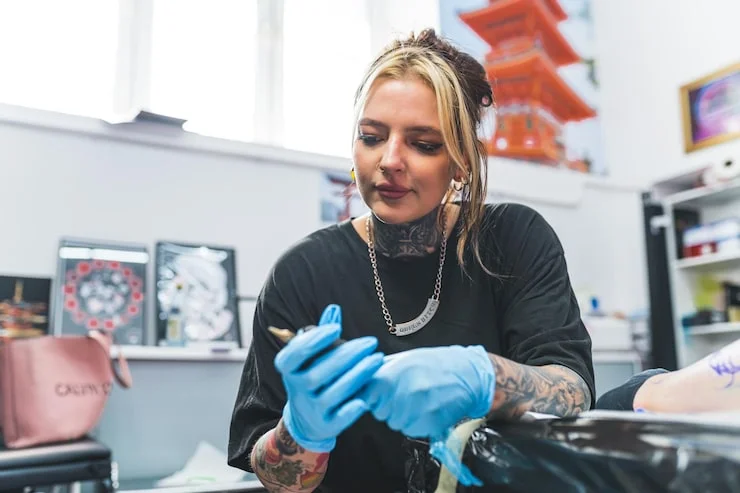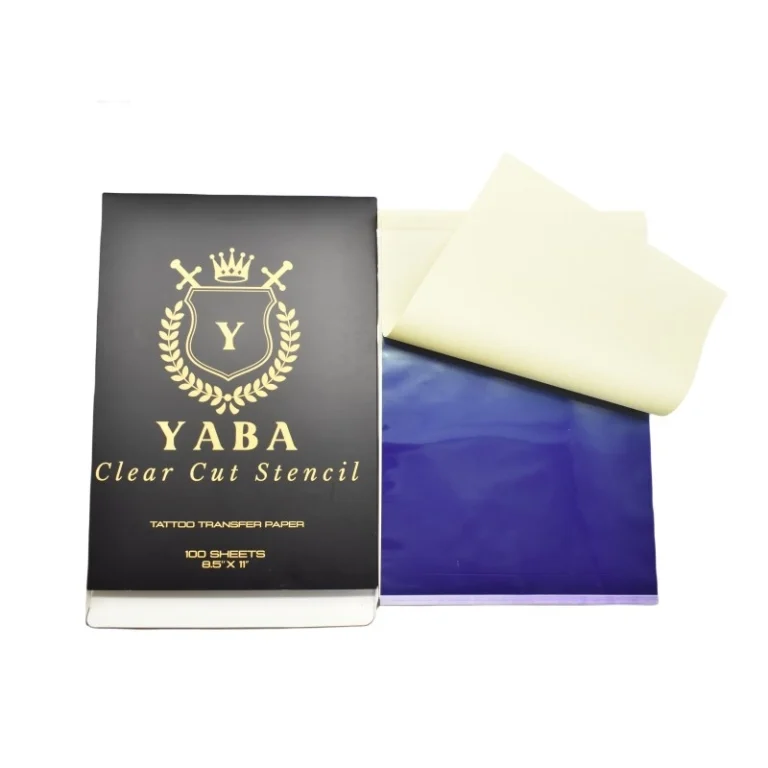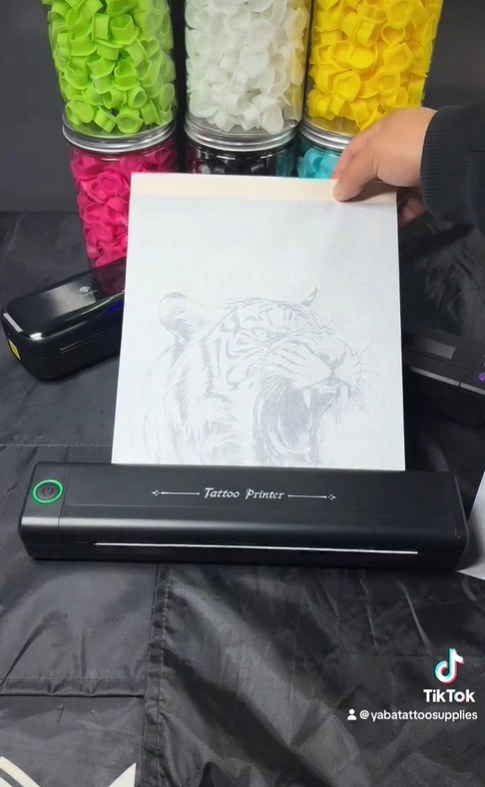Tattooing blends art and skill beautifully. It mixes creativity with exactness. Artists use different ways to put designs on skin. Two common methods are tattoo outline stencils and freehand drawing. Each has special strengths. They shape the final tattoo in unique ways.
The Value of Accuracy and Flow in Today’s Tattooing
In today’s tattooing, balance is key. You need both beauty and precision. Whether it’s a big sleeve or a tiny design, the method matters a lot. It affects the tattoo’s success. Tattoo outline stencils give structure. They help repeat designs accurately. Freehand drawing, though, brings a lively flow. It adjusts to each person’s body shape.
What Are Tattoo Outline Stencils and Freehand Drawing?
Before we compare, let’s clarify what these methods are.
What Are Tattoo Outline Stencils?
Tattoo outline stencils are ready-made templates. Artists transfer them to skin using thermal printers or hand-tracing. These guides help outline the tattoo. They keep lines steady and proportions correct.
How Freehand Drawing Works in Tattooing
Freehand drawing means sketching directly on skin. Artists use markers or skin-safe pens. This method depends on the artist’s talent and vision. It lets them shape the design to match the body’s natural curves.
Key Benefits of Tattoo Outline Stencils
Tattoo outline stencils are popular in studios. They are reliable and save time.
Boosting Accuracy and Consistency
Stencils copy the original design exactly. They help keep symmetry and proportion. This is vital for geometric shapes, portraits, or text. With stencils, artists can pause and resume work without mistakes. The design stays the same across sessions.
Saving Time for Complex Designs
Stencils speed up setup for detailed tattoos. Artists can focus on tattooing, not redrawing. This cuts down errors during long sessions. Fatigue can make freehand work less precise, but stencils stay steady.
Perfect for Copying Detailed Artwork
When clients bring specific designs, like mandalas or biomechanical tattoos, stencils shine. They place every line exactly as planned. Doing this freehand takes a lot of effort and planning.
Advantages of Freehand Drawing in Tattooing
Stencils are structured, but freehand drawing offers creative freedom.
Fitting Perfectly to the Client’s Body
Freehand drawing adapts to the body’s shape. Artists tweak designs to follow muscles or bones. This makes tattoos look natural. They flow with the body’s lines.
Creative Freedom for Artists
Freehand lets artists express ideas freely. They can add shading or background details on the spot. They aren’t stuck with a fixed outline.
Blending Foreground and Background Smoothly
For big tattoos, like sleeves or back pieces, freehand drawing helps. Artists blend main elements with backgrounds smoothly. There are no harsh edges from stencil lines. The design feels whole.
Limits of Tattoo Outline Stencils
Stencils are helpful but have some downsides that limit creativity.
Blocking Creative Changes
Stencils are fixed. Once applied, they don’t change easily. This can limit last-minute tweaks or new ideas during tattooing.
Relying on Pre-Made Templates
Artists who use stencils a lot may lose confidence in freehand skills. Also, if a stencil smudges or shifts, it can mess up the process. This slows down the work.
Challenges of Freehand Drawing
Freehand tattooing is exciting but tough. It needs a lot of skill.
Needing Advanced Art Skills
Not all artists can draw directly on skin confidently. Freehand work needs knowledge of anatomy and proportion. These skills take years to develop.
Risk of Uneven Designs
Without stencils, mistakes can happen. Curved body parts, like shoulders or ribs, make straight lines tricky. Even skilled artists can struggle with symmetry.
When to Pick Tattoo Outline Stencils Over Freehand
Some projects need stencils for their precision.
Designs Needing High Detail and Balance
Tattoos with symmetry, like mandalas or sacred geometry, benefit from stencils. They ensure perfect alignment. Doing this freehand is hard to get right every time.
Working with Client-Approved Designs
When clients want exact copies of logos or digital art, stencils deliver. They match the original perfectly, without changes by the artist.
When Freehand Drawing Is the Better Choice
Some tattoos work best with a free, flowing approach.
Large Tattoos That Follow Body Shape
Big tattoos, like back pieces or sleeves, need to fit the body’s curves. Freehand drawing lets artists adjust the design naturally. It avoids forcing a stiff shape onto the skin.
Spontaneous or Creative Designs
Some clients want abstract tattoos made up during the session. Freehand allows artists to experiment. They can create without being tied to a set outline.
Mixing Both Methods for Great Results
Many pros combine stencils and freehand for the best outcome.
Hybrid Method: Stencils for Main Parts, Freehand for Extras
Artists often stencil key parts, like faces or text, for accuracy. Then, they draw details like leaves or smoke by hand. This mixes precision with flexibility.
Saving Time While Keeping Creativity
Using stencils for main elements speeds things up. Adding freehand touches keeps the design fresh. This is great for big projects that evolve over multiple sessions.
Yaba: A Trusted Supplier of Tattoo Outline Stencil Tools
For artists who need stencil tools, Yaba offers top-notch solutions. They are made for professional tattooists. Yaba’s Bluetooth Thermal Printers make crisp stencils fast. They use wireless connections, so artists can print from phones or tablets. This cuts out bulky desktop setups, perfect for busy studios or conventions.
Yaba Tattoo Stencil Thermal P-19 Bluetooth Printer Features
The Yaba P-19 Bluetooth Printer gives high-quality output. It works with standard stencil paper. It supports Android and iOS apps for easy image tweaks. This ensures precise layouts before applying to skin.
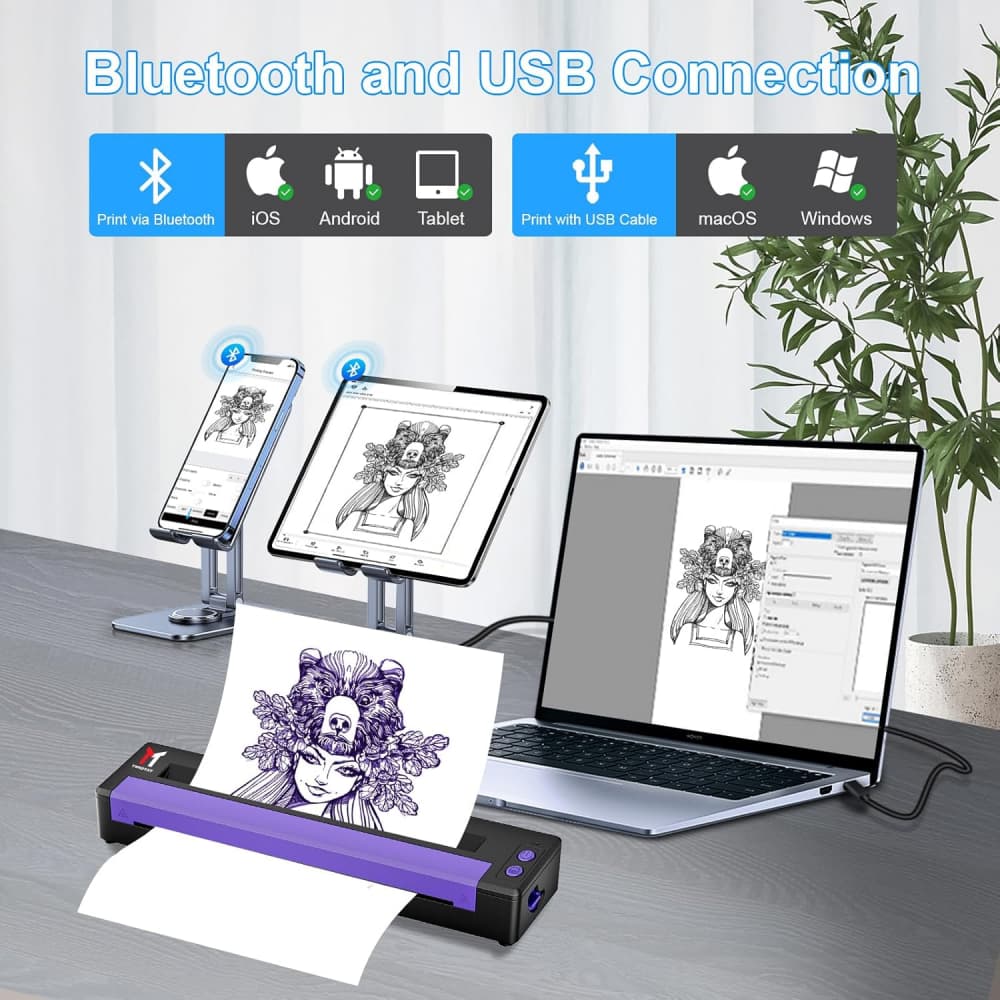
Yaba Phomemo TP31 Pocket Printer Benefits for Mobile Artists
The Phomemo TP31 Pocket Printer is small but strong. It fits in travel kits and works reliably. It’s great for artists on the go, like at conventions or private gigs outside studios.
Focus on Quality, Portability, and Artist Support
Yaba builds tools that last. They are easy to use and deliver pro-level results. Whether you’re doing big back tattoos or small linework, Yaba helps under tight deadlines.
FAQs
Q1: What’s better for beginners—tattoo outline stencils or freehand drawing?
A: For new tattoo artists, stencils are easier. They provide a guide and reduce mistakes. Beginners can focus on needle skills before trying freehand.
Q2: Can I use both stencil and freehand in one tattoo?
A: Yes! Many skilled artists use stencils for main parts and freehand for extra details. This gives a mix of accuracy and creative flow.
Q3: Are portable thermal printers like Yaba’s reliable for pros?
A: Definitely. Yaba’s printers, like the P-19 Bluetooth model, produce high-quality stencils. They work with standard stencil paper and are trusted by pros worldwide.

